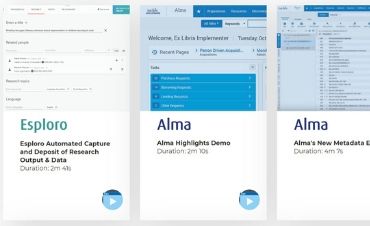Eddie Neuwirth, Director of Product Management – Discovery Services, Ex Libris
Any bias within a system is a serious issue when people rely upon that system for information. Historically, conversations about bias have focused on the media as a powerful tool to influence people. On university and college campuses worldwide the topic of bias, usually in a social or political context, continues to be an important and ongoing challenge for academia. Most recently, conversations about various internet services and the technology companies behind them have even suggested that technologies and vendors such as Facebook could influence the outcome of elections because of their proprietary search algorithms.
In a New York Times op-ed and other research, Zeynep Tufekci, associate professor at the School of Information and Library Science at the University of North Carolina at Chapel Hill, argues that Facebook’s search algorithm is certainly biased. With its propensity to favor more upbeat information over more challenging subjects, Tufekci suggests that Facebook can limit the information flow of important topics. This, in turn, can affect the information that users are exposed to and ultimately consume.
If bias finds its way into a library discovery service, particularly in an academic setting, the stakes are high – research integrity could be negatively impacted. Matthew Reidsma, Web Services Librarian, Grand Valley State University and Editor-in-Chief, Weave Journal of Library User Experience, recently provided a compelling overview on the topic of algorithmic bias in library discovery services. Reidsma’s research points out how algorithmically driven features can unwittingly introduce or reinforce social biases (such as gender discrimination) without human intervention to correct course.
It is highly unlikely that any library service vendor would knowingly put forth a discovery service that intentionally biased results toward particular information topics, or that intentionally pushes a social agenda. There is no incentive to do so. However, the idea that a discovery service could be designed and unintentionally skewed to favor content from one content provider over another is not so far-fetched. This is because content neutrality goes beyond the idea of possible algorithmic manipulation through relevancy ranking.
Many focus on the relevance algorithms as the most likely source of content bias in discovery services, but it is also how the discovery service is constructed, as well as elements of its user experience, that can impact and influence the content that users see and interact with. Factors leading to bias could include methods for de-duplicating content, presentation and quality of links to content, interface design and branding, and more. Ultimately, the system design of a library discovery service is complex, and ensuring content neutrality by removing bias can be difficult.
Libraries should call for discovery providers to commit to content-neutral practices in discovery systems to minimize any potential bias. Library discovery services that aim to be content neutral and unbiased should consider the following six principles:
- Make content equally discoverable. Fair and equitable treatment of the metadata that the discovery tool provider uses is fundamental to content neutrality.
- Ensure that technical considerations are balanced. To prevent biased results, it is important that the relevancy-rankings approach does not introduce a bias by favoring one provider over another.
- Keep platforms separate, in delivery and in visual presentation. When a content provider also furnishes a discovery system, each should run on a separate platform.
- Make content-neutrality the default. Libraries shouldn’t be burdened with making extensive changes to the system configuration just to achieve content neutrality.
- Make delivery equitable. Access to full text should be treated the same regardless of source.
- Provide a neutral user interface. The user interface should be impartial and not influence the selection of resources.
We invite you to read our Guide to Evaluating Content Neutrality in Discovery Systems to better understand content neutrality, the principles for evaluating discovery systems, and questions librarians can ask of vendors about their own discovery services.
Stay tuned: our next blog post in this 3-part series on content neutrality will focus on questions librarians can ask to ensure unbiased discovery. To view the previous post in this series click here.
Click here to access our content neutrality guide
Follow @ExLibrisGroup
September 15, 2016






